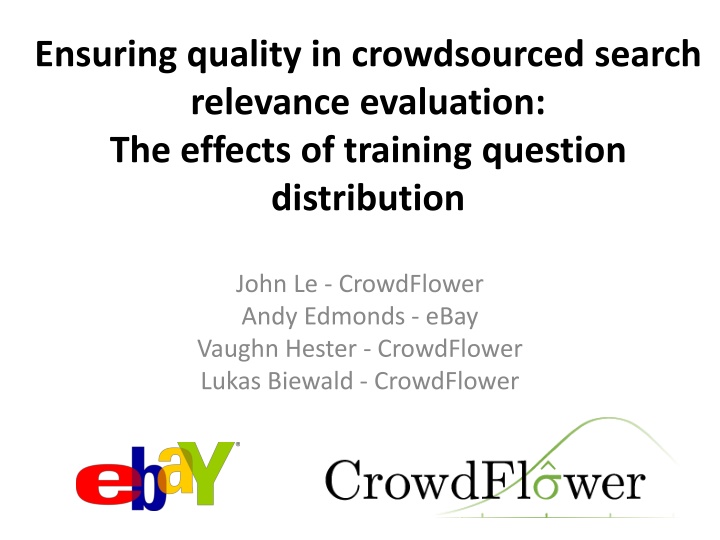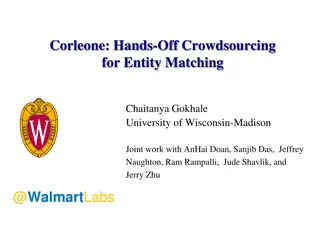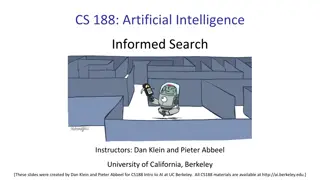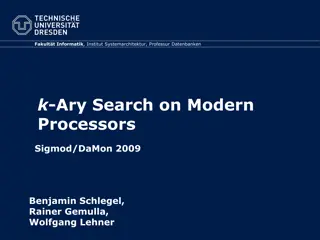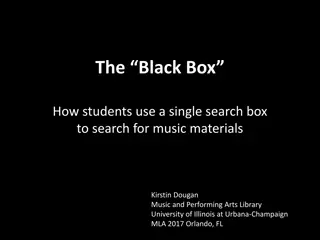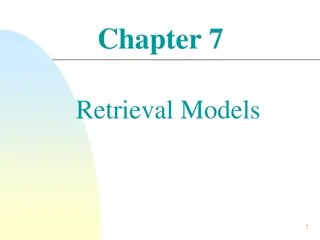Ensuring Quality in Crowdsourced Search Relevance Evaluation
In this study, the effects of training question distribution on search relevance evaluation are explored. The experiment focuses on the impact of training data setup and distribution on worker output and final results, emphasizing the importance of quality control. Through dynamic learning techniques and initial training periods, the research aims to quantify and understand the influence of training data distribution. The experiment, conducted via AMT using Mechanical Turk and the CrowdFlower platform, analyzed judgment datasets from a major online retailer. Experimental manipulations were employed to assess how judge training question-answer distribution skews affect the outcomes. Key contributions include insights into quality control mechanisms in crowdsourcing and the significance of training data impact evaluation.
Download Presentation

Please find below an Image/Link to download the presentation.
The content on the website is provided AS IS for your information and personal use only. It may not be sold, licensed, or shared on other websites without obtaining consent from the author.If you encounter any issues during the download, it is possible that the publisher has removed the file from their server.
You are allowed to download the files provided on this website for personal or commercial use, subject to the condition that they are used lawfully. All files are the property of their respective owners.
The content on the website is provided AS IS for your information and personal use only. It may not be sold, licensed, or shared on other websites without obtaining consent from the author.
E N D
Presentation Transcript
Ensuring quality in crowdsourced search relevance evaluation: The effects of training question distribution John Le - CrowdFlower Andy Edmonds - eBay Vaughn Hester - CrowdFlower Lukas Biewald - CrowdFlower
Background/Motivation Human judgments for search relevance evaluation/training Quality Control in crowdsourcing Observed worker regression to the mean over previous months
Our Techniques for Quality Control Training data = training questions Questions to which we know the answer Dynamic learning for quality control An initial training period Per HIT screening questions
Contributions Questions explored Does training data setup and distribution affect worker output and final results? Why important? Quality control is paramount Quantifying and understanding the effect of training data
The Experiment: AMT Using Mechanical Turk and the CrowdFlower platform 25 results per HIT 20 cents per HIT No Turk qualifications Title: Judge approximately 25 search results for relevance
Judgment Dataset Dataset: major online retailer s internal product search projects 256 queries with 5 product pairs associated with each query = 1280 search results Examples: epiphone guitar , sofa, and yamaha a100.
Experimental Manipulation Judge Training Question Answer Distribution Skews Experiment 1 2 3 4 5 Matching 72.7% 58% 45.3% 34.7% 12.7% Not Matching 8% 23.3% 47.3% 56% 84% Off Topic 19.3% 18% 7.3% 9.3% 3.3% Spam 0% 0.7% 0% 0.7% 0% Underlying Distribution Skew Matching Not Matching Off Topic Spam 14.5% 82.67% 2.5% 0.33%
Experimental Control Round-robin workers into the simultaneously running experiments Note only one HIT showed up on Turk Workers were sent to the same experiment if they left and returned
Results 1. Worker participation 2. Mean worker performance 3. Aggregate majority vote Accuracy Performance measures: precision and recall
Worker Participation Not Matching skew Matching skew Experiment 1 2 3 4 5 Came to the Task 43 42 42 87 41 Did Training 26 25 27 50 21 Passed Training 19 18 25 37 17 Failed Training 7 7 2 13 4 Percent Passed 73% 72% 92.6% 74% 80.9%
Mean Worker Performance Not Matching skew Matching skew Worker \ Experiment 1 2 3 4 5 Accuracy (Overall) 0.690 0.708 0.749 0.763 0.790 Precision (Not Matching) 0.909 0.895 0.930 0.917 0.915 Recall (Not Matching) 0.704 0.714 0.774 0.800 0.828
Aggregate Majority Vote Accuracy: Trusted Workers 3 2 5 4 1 Underlying Distribution Skew
Aggregate Majority Vote Performance Measures Not Matching skew Matching skew Experiment 1 2 3 4 5 Precision 0.921 0.932 0.936 0.932 0.912 Recall 0.865 0.917 0.919 0.863 0.921
Discussion and Limitations Maximize entropy -> minimize perceptible signal For a skewed underlying distribution
Future Work Optimal judgment task design and metrics Quality control enhancements Separate validation and ongoing training Long term worker performance optimizations Incorporation of active learning IR performance metric analysis
Acknowledgements We thank Riddick Jiang for compiling the dataset for this project. We thank Brian Johnson (eBay), James Rubinstein (eBay), Aaron Shaw (Berkeley), Alex Sorokin (CrowdFlower), Chris Van Pelt (CrowdFlower) and Meili Zhong (PayPal) for their assistance with the paper.
Thanks! QUESTIONS? john@crowdflower.com aedmonds@ebay.com vaughn@crowdflower.com lukas@crowdflower.com
